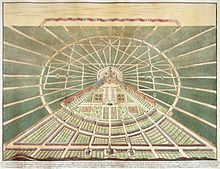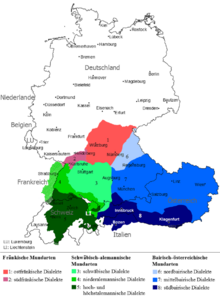|
Margraviate of Baden-Durlach
The Margraviate of Baden-Durlach was an early modern territory of the Holy Roman Empire, in the upper Rhine valley, which existed from 1535 to 1771. It was formed when the Margraviate of Baden was split between the sons of Margrave Christopher I and was named for its capital, Durlach. The other half of the territory became the Margraviate of Baden-Baden, located between the two halves of Baden-Durlach. Baden-Durlach became Lutheran during the Protestant Reformation, unlike Baden-Baden, which remained Catholic. Baden-Durlach occupied Baden-Baden from 1594 to 1622, but was driven out after being defeated at the Battle of Wimpfen, during the Thirty Years' War (1618–1648). The territory was ravaged during the Nine Years' War (1688–1697). Following the extinction of the Baden-Baden line in 1771, the Baden-Durlach inherited their territories and reunited the Margraviate of Baden. The reunified territory was caught up in the French Revolutionary and Napoleonic Wars, emerging in 1806 as the Grand Duchy of Baden. TerritoryThe Margraviate of Baden-Durlach encompassed an area on the middle Upper Rhine around the cities of Pforzheim and Durlach, as well as the Margraviate of Hachberg around Emmendingen, and an area known as Markgräflerland in the southern part of the Upper Rhine region, between Müllheim and Lörrach. In detail, the territorial components were as follows:[1] Lower Margraviate (c. 40% of the total area)[2]
Upper Margraviate (c. 60% of the total area)
Baden-Durlach held two individual votes (Virilstimme) on the temporal bench of the Imperial Diet, as well as a third individual vote for the Margraviate of Hachberg. It had the same representation of the diet of the imperial circle of Swabia. History  In 1535, the Margraviate of Baden was split into the Margraviates of Baden-Baden and Baden-Durlach. Margrave Charles II chose to support the Protestant Reformation in 1556 and transferred his residence from Pforzheim to Karlsburg Castle in Durlach in 1565. In 1594, Baden-Durlach exercised control over Baden-Baden in what is known as the Oberbadische Okkupation (Upper Baden Occupation), after Margrave George Frederick seized the territory in light of his relatives' bankruptcy. Having never received imperial authorisation for the seizure, George Frederick joined the Protestant Union in an effort to protect his claims.[3] This ended in 1622 during the Thirty Years' War, after George Frederick was defeated at the Battle of Wimpfen and forced to abdicate and return Baden-Baden to his relations.[4] During the Nine Years' War, Pforzheim and Durlach were burnt to the ground. From 1715, Margrave Charles III William built his new residence, Karlsruhe Palace, in an empty area. The city that developed around the palace would later become Karlsruhe. In 1771, Margrave Charles Frederick inherited the Margraviate of Baden-Baden, reunifying the Margraviate of Baden. The summer residence of the margraves of Baden-Durlach was the Markgräflerhof in Basel, Switzerland, where the margraves also owned a number of other properties. ArmsThe coat of arms underwent changes over time. Here the coat of arms depicted on the seal of Margrave Charles II is described: The central shield contained the red Badian diagonal band on a golden background. In the upper left field was the crowned red lion of the Landgraves of Sausenberg. The upper right field showed the wing of the lords of Üsenberg Castle. The lower left had a vertical band with three chevrons, the arms of the lordship of Badenweiler. In the lower right field was the red lion of the lords of Rötteln. The coat of arms was surrounded by five helmets. The upper middle one bears the Badian ibex horns. Alongside it is a helmet with the Sausenberg lion and one with the upper part of a man wearing the wing of the Üsenberg arms. On the left side of the arms is a helmet with the upper part of a young man, who wears the vertical band of the Badenweiler arms, and at right is a helmet with a bishop's mitre, symbolising the Schirmvogtei held by the lordship of Rötteln over several monasteries.[5] MilitaryAccording to the Imperial Register, the Margraviate was obliged to supply troops to the Swabian Circle. In addition to these troops, the Margraves also built up a force of household troops (a bodyguard). In 1770, the margraviate had a total of 807 soldiers in service (including both the circle troops and the household troops), consisting of four companies of a grenadier battalion, a fusilier division, and a company of dragoons.[6] The largest force raised in the history of Baden-Durlach was recruited by Margrave George Frederick in 1622 for the Palatinate campaign of the Thirty Years' War. It consisted of 11,500 men, only half of which were recruited locally from the margraviate's militia, with the rest on loan from George Frederick's allies; the territory was too small and poor to pay for professional soldiers beyond the margrave's own bodyguard.[3] George Frederick's army ceased to exist when he was defeated at the Battle of Wimpfen, the remnants of the army being absorbed by the Count of Mansfeld's forces.[7] CalendarBefore 1582, like the rest of the Empire, the Margraviate employed the Julian Calendar. In 1582, the Margraviate of Baden-Baden adopted the Gregorian Calendar, such that 4 October 1582 was followed directly by 15 October 1582, but Baden-Durlach, as a Protestant state, retained the Julian Calendar, since the new calendar had been promulgated by the Pope. The Corpus Evangelicorum in the Imperial Diet agreed to adopt the Gregorian Calendar only in 1699. Baden-Durlach followed the decision and adopted the new calendar in 1700, with 18 February being followed directly by 1 March 1700.[8] Some parish books from the Margraviate show that individual churches did not all follow suit immediately. ReligionInitially, the Margraviate was Roman Catholic, like the rest of the Holy Roman Empire, but on 1 June 1556, Margrave Charles II decreed a new Church Order on the Württemberg (i.e. Lutheran) model and initiated the Reformation in his territory. Although his two oldest sons abandoned Lutheranism (Ernest Frederick converted to Calvinism in 1599 and James III converted to Catholicism in 1590), Baden-Durlach remained Lutheran since the third son, George Frederick did not convert, outlived his brothers and inherited both of their territories. The Margrave was also the leader of the local Protestant church. The daily administration of the churche was dealt with by a Church council (Kirchenrat). Two General Superintendents were appointed, one for the Lower territories and another for the Upper territories, who oversaw the Special Superintendents who administered the individual dioceses, which in turn administered the individual parishes. Consistency of doctrine was maintained by regular visitations. CultureDialect Even in language, the Margraviate was not unified. The Landgraviate of Sausenberg and the Lordships of Badenweiler und Rötteln spoke High Alemannic, while the Margraviate of Hachberg used Low Alemannic and the Lower Margraviate (Karlsruhe-Pforzheim) employed a South Franconian dialect. EducationThe Margraviate never had a university. However, the level of the highest school, the gymnasium illustre in Karlsruhe, was at times equivalent to a university. Originally, the institution mainly served to educate orthodox priests to safeguard the Reformation. The school was established in Durlach in 1586 and transferred to Karlsruhe by Charles III William in 1724.[9] It is now the Markgrafen-Gymnasium Karlsruhe. Music and theaterThe Badische Staatskapelle symphony orchestra is first attested in 1662. Its masters were: Enoch Blinzig (1707–1708), Giuseppe Beniventi (1712–1718), Johann Philipp Käfer (1718–1722), Johann Melchior Molter (1722-1733 and 1743–1765), and Giacinto Sciatti (1765–1776). List of margravesFrom 1577 to 1584 and 1738 to 1746, there were regencies for underage rulers. These regents are mentioned in the text, but not listed asmargraves.
See alsoReferences
Sources
Description of the condition of the margraviate in at the beginning of Karl Frederick's reign:
External linksWikimedia Commons has media related to House of Baden-Durlach. Wikisource has original text related to this article:
|
||||||||||||||||||||||||||||||||||||||||||||||||||||||||||||||||||||||||||||||||||||||||










